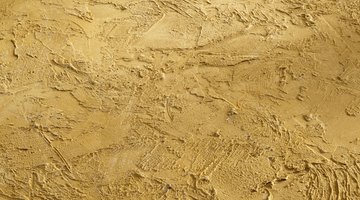How to Pebble Dash a Wall
Stucco is a commonly used finish for the outside of a home, but you don't have to simply use plain stucco. There are many ways to texture or finish stucco to give it a more unique appearance.

For instance, pebble dash, also known as dry dash, is a specific type of finish for stucco walls that essentially consists of pebbles or small stones embedded into the stucco, which results in an extremely durable finish with a rather rustic look.
Stucco
Stucco is made from a mixture of portland cement, sand, lime and water, and so is a very durable and stable material. It's heavy, though, and so most structures need some reinforcement both to hold the stucco and to ensure that it sticks properly to the structure. Stucco is applied in several coats. The traditional method calls for three coats, a scratch coat used to help the other coats adhere, a brown coat and then a finish coat that has the final texture. Modern materials can eliminate the brown coat, though, leaving the scratch and finish coats.
Pebble Dash
Stucco requires several coats to properly adhere and achieve the best possible appearance. Pebble dash is always applied to the final coating. Normally, applying pebble dash is a two-person job. One person applies fresh stucco to the wall, while the other throws small stones, usually 1/8 to 1/4 inch in diameter, at the stucco using a scoop. It's necessary to have two people to make this efficient, since the stucco needs to be fresh for the pebbles to stick. Afterward, the texture is sometimes smoothed and flattened with a wooden float.
Other Methods
Rather than "fling" pebbles at a wall, you could potentially put them in by hand. This is an appealing alternative if you want the arrangement to be even and consistent or if you want a mosaic-like effect or if you want to use large pebbles that can't be "flung." You may only want to use a technique like this for accents, though, since you have to put in the stones before the stucco is too dry, meaning that working with small areas at a time is the simplest method.
Wet Dashing
You may also be interested in a variation on the pebble or dry dashing texture, a method known as wet dashing. With wet dashing, the stones are mixed directly into the stucco and then the mixture is applied to the wall. This will result in a heavily textured exterior coating that is even more durable than pebble dash. The pebbles will not be visible, but the texture of the stucco and pebble mixture will be. A wet dashed wall can be painted if desired, whereas paint on a pebble dashed wall covers up the pebbles.
References
Photo Credits
- Brand X Pictures/Brand X Pictures/Getty Images
- Brand X Pictures/Brand X Pictures/Getty Images
More Articles



